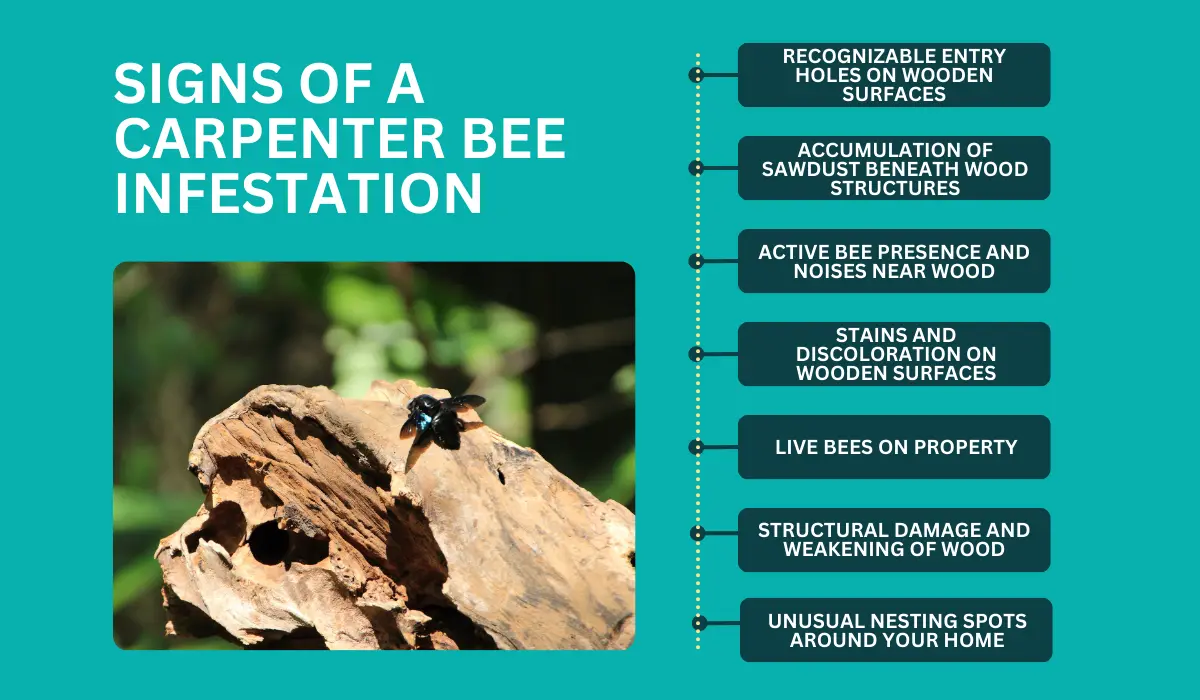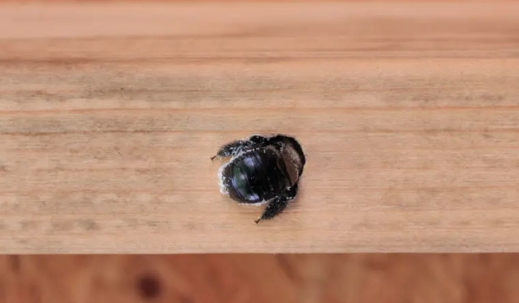Telltale Signs Your Florida Home May Have Carpenter Bees
Spotting signs your home may have carpenter bees in Florida can save you a lot of hassle and potential damage.
Look for perfectly round holes about half an inch in diameter in wooden structures around your home. These are often the entry points where carpenter bees drill into wood to lay their eggs.
Hearing a soft buzzing sound around wooden areas or noticing bees hover around? Keep reading to discover how to identify and deal with carpenter bees effectively.
Key Takeaways
- Round, 1/2-inch diameter entry holes on wood, fresh sawdust accumulations, buzzing noises, stains on wood, and sightings of shiny black bees indicate a carpenter bee infestation.
- Citrus oil sprays, plugging existing holes with wooden dowels or putty, installing bee traps, and applying insecticidal dust to affected areas are effective DIY methods for controlling carpenter bee populations.
- Extensive damage, such as multiple tunnels and structural weakening, suggests a severe infestation that may require the expertise of professional pest control services.
What Are the Signs of a Carpenter Bee Infestation?

Carpenter bees leave specific clues indicating their presence. As homeowners, you should be vigilant when looking for these various signs.
Recognizable Entry Holes on Wooden Surfaces
Carpenter bees create noticeable entry holes on wooden surfaces. These openings are typically round and about 1/2-inch in diameter. These holes allow them to dig tunnels for female bees to lay eggs.
Holes are often found in the following places:
- Eaves
- Fascia boards
- Decks
- Wooden railings
- Siding
Accumulation of Sawdust Beneath Wood Structures
As carpenter bees bore holes into the wood, they produce piles of sawdust or frass. However, you have to note that not all frass are the same. Fresh sawdust accumulations indicate recent activity.
Here’s how you can detect one from the other:
Tips | Fresh Sawdust | Old Sawdust |
Color | Light-colored | Darker, weathered |
Location | Piled right below holes | Dispersed, might be moved by the wind |
Texture | Fine, like wood pulp | Finer, and sometimes clumped |
Active Bee Presence and Noises Near Wood
Carpenter bees are pretty active around their nest sites unless disturbed. As homeowners, you might notice buzzing sounds and other activities, such as:
- Male carpenter bees often hover nearby, guarding the entry points.
- Their buzzing sounds are loud and sustained.
- Unlike wasps, bumblebees, or honey bees, their noise focuses more on the wooden structures where they nest.
Stains and Discoloration on Wooden Surfaces
Carpenter bee activity can leave behind unsightly stains and discoloration on wood surfaces. This is due to oily secretions that mark territory in contact with frass.
While these signs might go unnoticed initially, leaving them untreated can cause permanent wood damage. Here’s what they look like:
Signs | What They Look Like |
Stains | Yellowish, due to excrement |
Discoloration | Faded or dark patches around entry holes |
Live Bees on Property
Seeing live bees around your property, especially in increased numbers, indicates an infestation. With more frequent sightings suggesting a growing nest site, here’s how to tell them apart from the bumble or honeybees:
- Black abdomens with a shiny appearance
- Range in size from 3/4 to 1 inch (19-25 mm) long
- Less fuzzy, prominent thorax
- Stingers present in female carpenter bees
Structural Damage and Weakening of Wood
Over time, carpenter bees contribute to structural damage, much like woodpeckers and termites. As the damage varies by severity and wood type, consider this to guide you:
Damage Stages | Description | Impacted Wood Types |
Early | Small tunnels, minimal weakening | Softwood: pine, cedar |
Moderate | Multiple tunnels, minor structural impact | Untreated wood |
Severe | Extensive tunnels, significant structural damage | Redwood, framing wood |
Unusual Nesting Spots Around Your Home
You can often spot carpenter bee nests in wooden structures on your property. However, when they’re preparing to overwinter, it would mean they can nest elsewhere, such as:
- Decks
- Sheds
- Attics
- Wooden playsets
- Painted wood
- Cracks in old structures
How to Get Rid of Carpenter Bees
Removing carpenter bees involves careful and timely interventions to avoid harming these beneficial pollinators.
DIY Carpenter Bee Control
DIY solutions for carpenter bee control can work temporarily, but they might not be the best long-term approach. Before calling the phone number of professional exterminators, here's how you can get rid of carpenter bees on your property:
DIY Solutions | Usage |
Citrus Oil Spray | Spray areas like eaves and railings with citrus oil to deter bees from those spots. |
Plugging Holes | After bees leave, plug their nesting holes with wooden dowels or putty to prevent returned usage. |
DIY Traps | Install traps near bee activity areas to capture and kill carpenter bees. |
Insecticidal Dust | Apply in and around bee holes. Effective, but use caution due to the presence of chemicals. |
Commercial Insecticides | Choose products that target carpenter bees and apply them according to the label. |
Proactive Measures to Discourage Carpenter Bee Activity
Long-term prevention is essential to prevent carpenter bee stings. To keep them at bay, follow these strategies:
- Inspect wooden structures: Check for new holes or bee activity.
- Seal and paint surfaces: Regularly repaint exposed wood.
- Use treated or composite materials: Opt for bee-resistant construction materials.
When to Call Professional Pest Control Services
You may only notice the carpenter bee problems when the wood shows signs of holes and sawdust. This typically can mean the infestation is more extensive than initially thought.
So, it’s best to calla professional pest control company (like us at Native Pest Management) for a free quote.
As professional pest control, we not only perform bee removal safely but also prevent future infestations. This is especially helpful since we have the right tools and know the best methods to handle carpenter bees efficiently.
